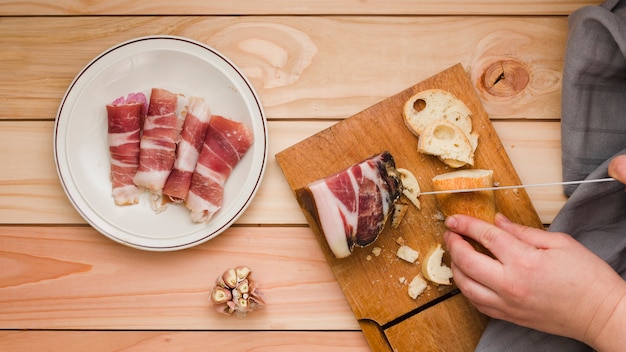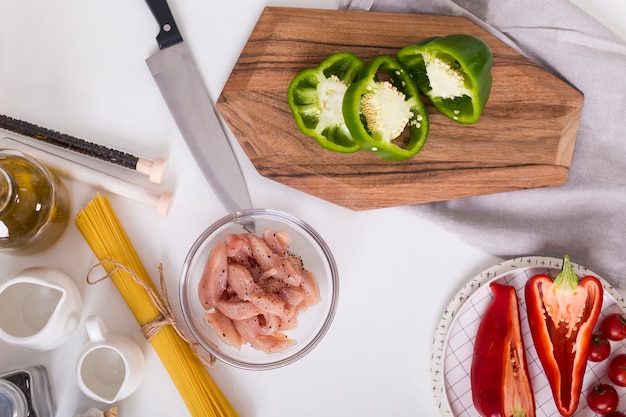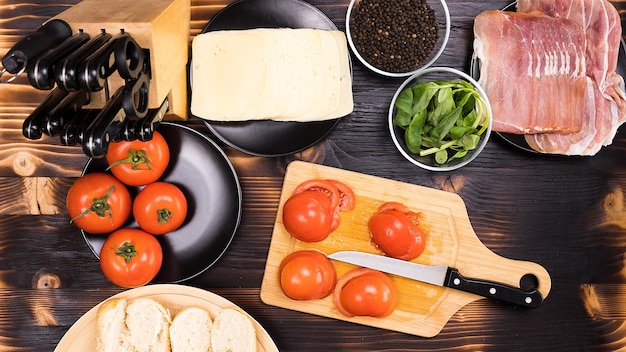Ah, ham steaks. Those thick, succulent slices of cured pork that promise pure comfort food bliss. I've been a ham steak enthusiast for years, and let me tell you, there's an art to getting them just right. Whether you're a seasoned chef or just starting out, this guide will walk you through every step, from choosing the perfect cut to creating a symphony of flavors on your plate. Get ready to impress yourself (and maybe a few dinner guests) with juicy, delicious ham steaks that are sure to become a new favorite.
(Part 1) The Art of Selecting the Right Ham Steak

The journey to a sensational ham steak begins with the star ingredient itself. I've spent countless hours in butcher shops, chatting with seasoned professionals, and I've learned a thing or two about choosing the right cut. It's not just about grabbing the first one you see; it's about understanding what makes a truly great ham steak.
Bone-in vs. Boneless: A Tale of Two Steaks
First things first, you'll typically encounter two main types: bone-in and boneless. bone-in ham steaks, often hailed as the more flavorful option, are a testament to old-school charm. The bone adds a depth of flavor that's hard to replicate, and there's something undeniably satisfying about carving the meat off the bone. boneless ham steaks, on the other hand, are all about convenience. They're often easier to manage and cook, especially for those who prefer a more streamlined experience.
The Colour Code: A Visual Guide to Quality
Next, let's talk about the visual cues. A quality ham steak should have a nice, even pink hue throughout. You want to see some marbling, those streaks of white fat that are like culinary jewels, adding both flavor and tenderness. Stay away from any steaks that appear dry, discolored, or have an off-putting smell. Trust your senses, they're your best guides.
Thickness and Size: A Matter of Preference
The thickness of your ham steak is another crucial consideration. Thicker steaks take longer to cook but also hold onto their moisture better, resulting in a more succulent bite. Now, I'm a fan of steaks that are about ?? to 1 inch thick. This sweet spot allows for a perfect balance of cooking time and tenderness. Of course, you can always adjust your cooking method and time based on your preference.
(Part 2) Prepping for Flavor: The Essential Steps

You've found your perfect ham steak, now it's time to prep it for culinary greatness. Think of this stage as prepping the canvas for your masterpiece. These steps are essential for unleashing the full potential of your ham steak.
The Skin Removal: A Quick and Easy Trick
If your ham steak comes with skin, it's time to remove it. I've got a simple trick that's been passed down from generations: Score the skin in a criss-cross pattern using a sharp knife. This makes peeling it off a breeze, leaving you with a smooth, even surface that will cook evenly. If you're feeling adventurous, save the skin for a crunchy, salty treat after cooking. That crispy texture is just addictive.
Patting Dry: The Secret to a Perfect Crust
This might seem like a small detail, but it's crucial: pat that steak dry with paper towels. Removing any excess moisture ensures a beautiful brown crust that adds a layer of irresistible crunch. Think of it as the final touch that elevates your ham steak from good to great.
Seasoning with Love: A Symphony of Flavors
Now, here's where the real fun begins. Seasoning your ham steak is like painting a masterpiece with flavor. I'm a classicist at heart, and I love a simple mix of salt, pepper, and paprika. It's bold, it's classic, and it never fails to deliver. But don't be afraid to experiment! Think rosemary, thyme, garlic powder, even a pinch of cayenne for a bit of heat. Remember to season generously, as the flavors will mellow during cooking.
(Part 3) Cooking Methods: Unveiling the Possibilities

Your ham steak is prepped and ready to go, now it's time to unleash your culinary creativity! Each cooking method brings a unique texture and flavor profile, so finding your favorite is all about exploring and experimenting.
Pan-Frying: A Quick and Easy Weeknight Winner
This is my go-to method for those busy weeknights when you crave a delicious meal but are short on time. Heat a good quality pan over medium-high heat, add a splash of oil or butter, and then lay your seasoned ham steak in the pan. Let it cook for a few minutes on each side, until a beautiful golden crust develops. You'll know it's done when the internal temperature reaches 145°F (63°C). Feel free to elevate the flavor by adding onions or garlic to the pan for a delicious aroma and taste.
Baking: A Hands-Off Approach for Comfort Food Bliss
For a more relaxed cooking experience, baking is the way to go. Preheat your oven to 350°F (175°C) and place your seasoned ham steak on a baking sheet. You can even roast some vegetables alongside it for a complete, delicious one-pan meal. Bake for about 20-25 minutes, or until the internal temperature reaches 145°F (63°C). To take it up a notch, I like to baste my ham steak with some pan juices or honey during baking. It creates a beautiful glaze and adds a touch of extra moisture.
Grilling: Embracing Smoky Flavors and Outdoor Fun
For that irresistible smoky, char-grilled flavor, fire up your grill! Preheat it to medium-high heat, and grill your ham steak for 5-7 minutes per side, or until it reaches that perfect internal temperature. To infuse your steak with an even deeper smoky aroma, add some wood chips to your grill. I'm a fan of hickory or applewood chips, they add a subtle sweetness and smoky complexity that's hard to beat.
(Part 4) Elevate Your Ham Steak: A Sauce Symphony
Let's face it, a good sauce can elevate a simple dish to culinary stardom. Think of it as the final flourish, the finishing touch that brings everything together.
Simple Sauces: Classic Flavors that Never Fail
I always start with the classics. A simple glaze of honey and mustard is always a crowd-pleaser. It adds a touch of sweetness and tang that perfectly complements the ham steak. Or, go for a classic brown sauce, a tried-and-true companion for any savory dish. I like to add a splash of Worcestershire sauce to my brown sauce, it adds a depth of flavor that's hard to resist.
More Complex Sauces: Venturing into Culinary Creativity
If you're feeling adventurous, don't be afraid to create your own signature sauce. A mix of orange juice, ginger, and soy sauce is a delightful and tangy option. For a richer experience, try a sauce made with cream, Dijon mustard, and a sprinkle of herbs. Just remember, the sauce should enhance the flavor of the ham steak, not overpower it.
(Part 5) Presenting Your Culinary Masterpiece
Your ham steak is cooked to perfection, your sauce is ready to go, now it's time to bring your culinary creation to life on the plate. The right presentation can make your meal even more inviting and enjoyable.
The Perfect Sidekicks: Complementary Flavors and Textures
You've got to have the right supporting cast for your ham steak to shine. Think classic pairings like mashed potatoes, roasted vegetables, or a crisp green salad. I'm a sucker for a good side of coleslaw, it adds that refreshing crunch to cut through the richness of the ham steak. And don't forget about bread! A crusty baguette or some soft rolls are perfect for soaking up those delicious pan juices.
Presentation Matters: A Feast for the Eyes
It might sound a bit fussy, but presentation matters. A beautifully plated meal can enhance the dining experience. I'm a fan of using a simple white plate, it makes the colors of the ham steak and sides pop. Add a few sprigs of fresh parsley for a touch of color and fragrance, and you've got a visually appealing and delicious meal.
(Part 6) Leftover Magic: Transforming Culinary Treasures
Let's be honest, sometimes leftover ham steak is a reality. But don't even think about tossing it! Leftovers can be just as delicious as the original meal, especially if you get creative.
Ham Steak Sandwiches: A Quick and Easy Lunchtime Delight
This is a classic for a reason. Slice up your leftover ham steak, add some cheese, and enjoy it in a toasted roll. It's a quick and satisfying lunch or snack. I like to add some mustard or mayonnaise for extra flavor.
Ham Steak Salad: A Hearty and Protein-Packed Option
Slice up your leftover ham steak and toss it into a salad for a delicious and protein-packed meal. You can use any type of salad base you like, but I'm partial to romaine lettuce and a simple vinaigrette dressing.
Ham Steak Hash: A Comforting and Savory Dish
This is a great way to use up leftover ham steak, potatoes, and other vegetables. Simply dice everything up, cook it in a pan until golden brown, and season to your liking. It's a hearty and satisfying meal.
(Part 7) FAQs: Addressing Your Ham Steak Questions
Now, I know you might have some questions about cooking ham steaks. I've been there too! Here are some of the most common questions I get and my answers to them.
Q: Can I Cook a Ham Steak From Frozen?
A: It's not recommended. It's best to thaw your ham steak in the fridge overnight. This allows for more even cooking and avoids any potential food safety issues.
Q: How Long Can I Store Leftover Ham Steak?
A: Leftover ham steak can be stored in the refrigerator for up to 3-4 days. You can also freeze it for up to 2-3 months.
Q: Can I Cook a Ham Steak Without a Thermometer?
A: While a thermometer is always the most accurate way to ensure your ham steak is cooked to perfection, you can use some visual cues. The ham should feel firm to the touch and have a nice golden brown crust. Additionally, the juices should run clear.
Q: What Happens If I Overcook a Ham Steak?
A: If you overcook your ham steak, it will become dry and tough. It's best to cook it to the recommended internal temperature and avoid overcooking.
Q: What's the Best Way to Reheat Leftover Ham Steak?
A: Reheating leftover ham steak is best done in the oven or on the stovetop. You can also microwave it, but it's not the ideal method. Just make sure it's heated through to an internal temperature of 145°F (63°C).
(Part 8) Final Thoughts: Embracing culinary adventure
So there you have it! My ultimate guide to cooking the most delicious and juicy ham steaks. Remember, it's all about choosing the right cut, prepping it with care, and finding a cooking method that suits your taste. Don't be afraid to experiment with different flavors and sauces, and most importantly, have fun with it!
Now, if you've got any questions or want to share your own ham steak tips, feel free to leave a comment below. I'd love to hear from you!
Happy cooking!
Everyone is watching

Corn on the Cob: The Ultimate Guide to Perfectly Cooked Ears
Healthy MealsAh, corn on the cob. Just the name evokes images of sunny days, barbecues, and that sweet, juicy flavour that ...

Perfect Pork Roast Oven Cooking Time: A Guide to Delicious Results
Healthy MealsThere's something truly satisfying about a perfectly roasted pork. The aroma alone is enough to make your mout...

Ham Cooking Time: How Long to Bake, Smoke, or Boil a Delicious Ham
Healthy MealsAh, ham. It's a classic, isn't it? A real crowd-pleaser, especially around holidays. And when done right, it'...

Scallops: The Ultimate Guide to Perfect Cooking
Healthy MealsAh, scallops. Those delicate, sweet, and utterly delicious morsels of the sea. They hold a special place in my...

Spaghetti Squash: The Ultimate Guide to Cooking and Serving
Healthy MealsRemember that time you saw spaghetti squash at the supermarket, looking all bumpy and strange, and thought, "W...
